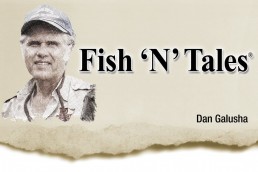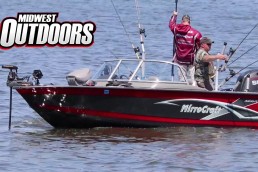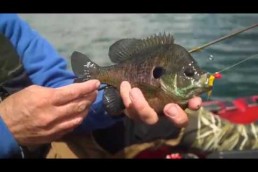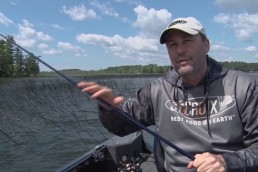Long-distance Fishing
SHARE THIS POST
If someone says that they are going to fish “long distance,” don’t think they are going to use the telephone. Instead, it should be the right combination of rod, reel, line and lure.
My long-distance fishing is done with a combination of six rod and reel outfits. Four are for long distance and two are for super-long distance. What this all means is that they are set up for very long casts from boats and from shore.
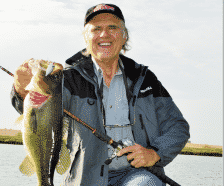
The rigs for a long distance consists of a 7-foot, medium-action Berkley Cherrywood casting rod for crankbaits, a 7-foot ultralight Agility casting rod for lures of 1/8 to 1/4 ounce, a 7-foot, medium Agility spinning rod for lures of 1/8 to 1/4 ounce and a 7-foot ultralight Agility spinning rod for lures at 1/16 to 1/8 ounce. Super-long distance rigs use an 8-foot Buzz Ramsey Steelhead Air Rod for a variety of lures and a 10-foot Berkley C-Series spinning setup for fishing panfish with heavier floats.
Reels that work to make long casts will match well. I prefer Garcia Revo and old Ultra Cast casting, Michell 300 spinning and Pflueger Supreme ultralight spinning reels. Line for spinning is all Nanofil, while the casting is a combination of different Berkley products that match well with the complete outfit, including the weight of lure being cast. Recommendations for the super-long casting is 6- to 8-pound-test Nanofil on the Pflueger Supreme for the 10-foot C-Series and 10- to 12-pound-test EZ Cast or Trans Optic for the 8-foot Buzz Ramsey rod.
I will use the long casting in a boat for basically two situations: paralleling a long shore or point in very clear water and casting well past an area of schooling fish. From shore, it is for reaching structures, such as weedlines and islands, old creek beds or any fish holding area that is a distance from shore.
As for lures, I don’t do a lot of super-long distance casts when fishing soft plastics with a Texas rig, but I will do a little of this with the long-distance casts as long as it is on a medium-action rod. In these situations, I make sure that the plastic is “skin-hooked,” using a very sharp hook. Skin-hooking is when the hook is punched through and the tip is pushed slightly into the outer layer, which makes the hook-set a “hair trigger,” making the set much easier.
Remember, the longer the cast, the more line and more stretch there is. It can be more difficult for a positive hook set.
The lures I use for this type of fishing are Blitz Blades, Rat-L-Traps, billed crankbaits, swimbaits, Casey’s Runners with a 4-inch Power Minnow and some other heavier Road Runner heads, Madbug Krickets, and on certain occasions, heavier spinnerbaits and jigs for swimming. As you can see, most of these are selected for weight and long-cast designs, the wiggle and ability to be used at different speeds with a stop-and-go or pump retrieve.
Shore
A deep weedline and weed islands in the middle of a small lake once were holding many species. The weather was cool to cold with high winds, making it difficult for any cast—let alone long ones. This is where the heavier lure with a streamlined design came into play. And with the colder water, it was perfect to pull out the Blitz Blade and use it on the Buzz Ramsey Steelhead rod. This rig not only hooked the fish that were a long distance from shore, but also played them perfectly.
Are you enjoying this post?
You can be among the first to get the latest info on where to go, what to use and how to use it!
With a similar situation, but for crappies and targeting a deep water brush pile at the edge of an old creek bed, the 10-foot C-Series rod was teamed with a Mr. Crappie large weighted slip float and Slab Daddy jig. The float was then drifted with the wind, which would automatically jig the Slab Daddy. This rod, as the Buzz Ramsey model, made it possible to hook and play the fish successfully from long distances. I caught bass in addition to the crappies.
Boat
A key time for using long distance is for schooling fish—and in this situation was the middle of creek arms in Bull Shoals Lake. I used the Buzz Ramsey rig and a 7-foot Cherrywood with an old Ultra Cast casting reel to cast Blades, Rat-L-Traps and Casey’s Runners. They were sent well past the schooling action and I brought the lures to the outside edge of the pods of baitfish so as to not to spook the fish hanging below the middle of the pod. In fact, if more distance is needed, the new Blitz 1-ounce Blade can be used without overpowering the lure’s profile. Even with the heavier weight, this lure still has a profile of smaller 3/8-ounce crankbaits. This time we caught white bass and Kentucky spotted bass.
Another situation was when fish were along bluff shores in very clear water. They hit a variety of lures, but the casts had to be made long enough and the motions of the boat had to be minimal to avoid spooking the fish. Once the cast was made long enough, any type of lure and retrieve could be used, including soft plastic tubes Texas rigged and on jig heads.
Setting the hook can be a challenge, as it was earlier. Because of this, being able to play the fish properly and keep it down from jumping is a must. This is where the long rod comes into play: More than just providing distance, these make it possible to have enough flex to give the fish some spring to help keep the hook from being thrown. Also, the long rod can be stuck in the water and downward to keep fish from coming to the surface to make a jump.
Not only is this a great way to locate fish that may otherwise not have been caught, but it is also a lot of fun. Playing a fish from a distance, especially super-long distances, adds a completely different level of enjoyment.
So next time you want to reach out and touch a fish in an area that may be untouched by other anglers, think of dialing up with long distance casts.
If you have any further questions about this or any other fishing subject, drop me a line through the Dan’s Fish ‘N’ Tales® website at dansfishntales.com, or Facebook page at facebook.com/dansfishntales.
MWO
SHARE THIS POST
Did you enjoy this post?
You can be among the first to get the latest info on where to go, what to use and how to use it!
Dan Galusha
Dan Galusha has fished all of his life, worked more than 45 years in the outdoor/media industry, and was inducted into the Fresh Water Fishing Hall of Fame as a Legendary Communicator. Direct questions through dansfishntales.com, facebook.com/dansfishntales and facebook.com/shootnplink.
